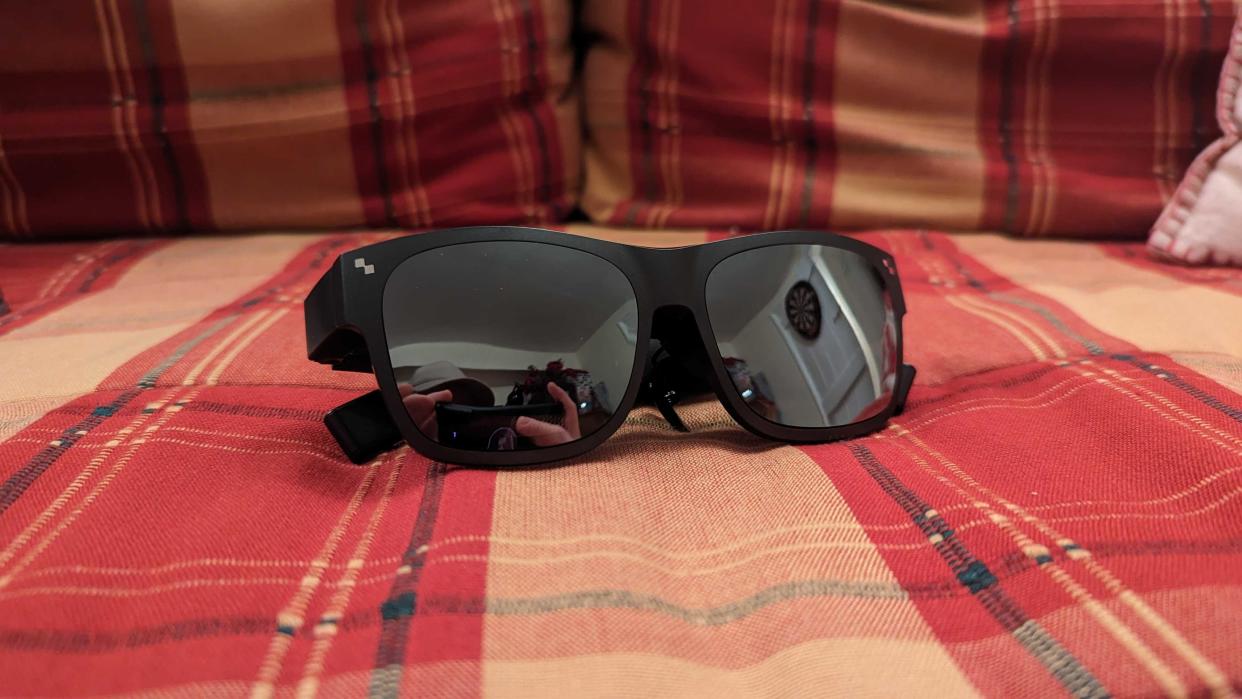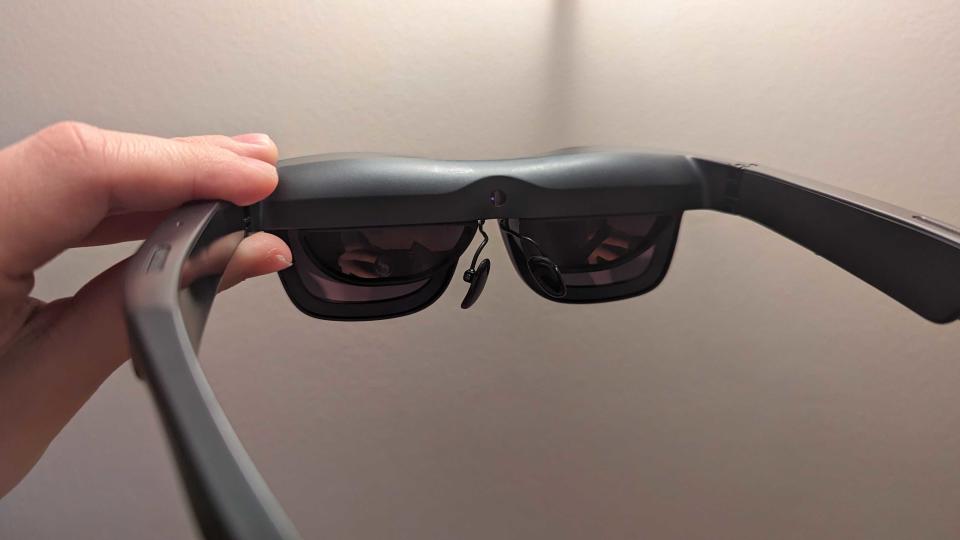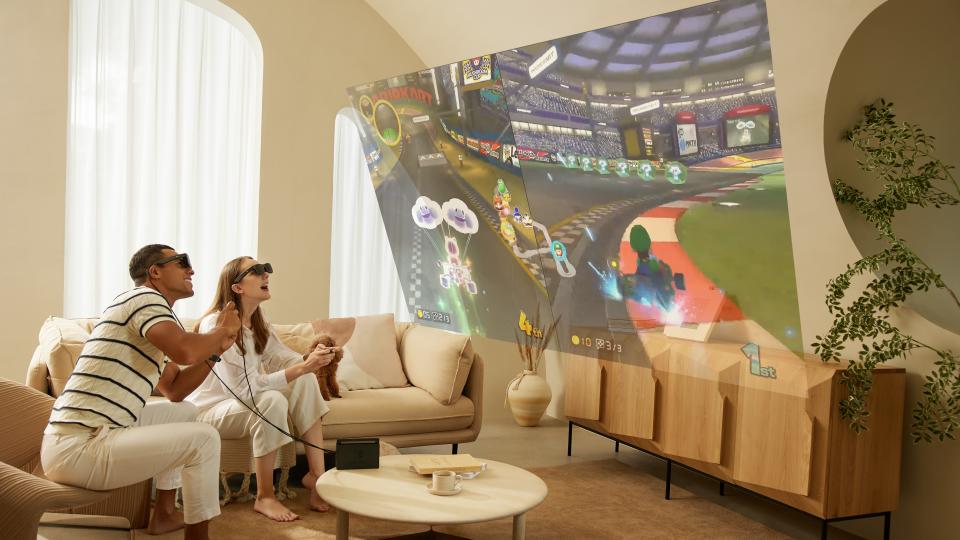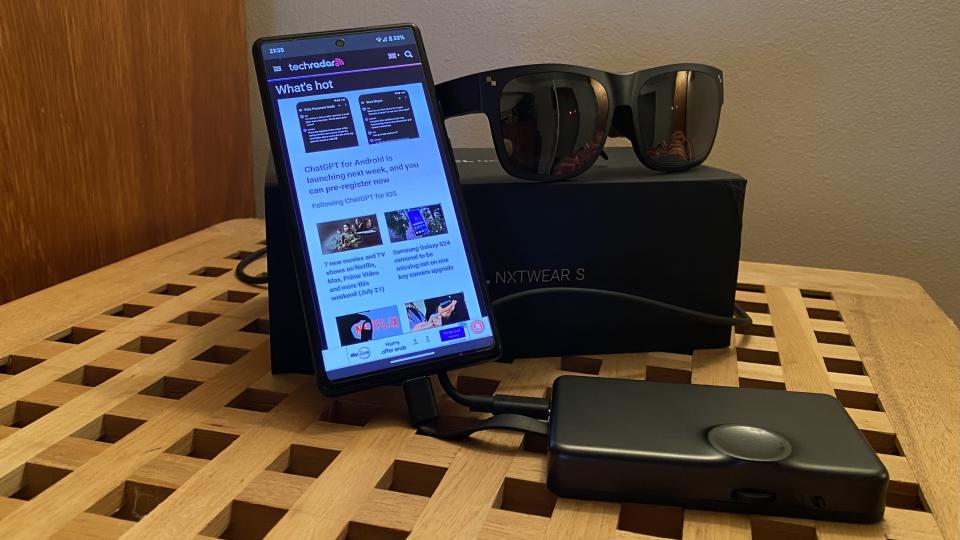TCL Nxtwear S AR glasses review: the XR future is clunky

TCL Nxtwear S: Two-minute review
The TCL Nxtwear S glasses are a solid choice for people who want an exceptionally portable second screen for their phone, laptop, or tablet. If you’re always working away from your desk or your workspace doesn’t have space for the number of displays you long for these specs will help you out.
Like other AR or XR smart glasses (XR being a catchall that includes AR, VR, and mixed reality), you connect these glasses to your device of choice using a USB-C cable – though it needs to support video output through a USB-C port, also known as DisplayPort. Doing so will project a copy of your device’s screen virtually (and privately) right in front of you. TCL says the full-HD image is comparable to seeing a 130-inch TV from 4m away. The image quality is pretty solid, with a good level of sharpness and decent contrast, though vibrant colors are a little muted – I just wish the screen felt bigger than it does.
Those of you with devices that like USB-C connections, like one of the best iPhones, or an Android phone that doesn’t support DisplayPort, such as the Google Pixel 7, can still enjoy the glasses’ AR features by using an additional Mobile Adapter. At $99 in the US (about £75 / AU$145), this is a substantial extra cost, and while the end result looks fine, it’s not as simple to use as it should be.
As someone who regularly reviews and uses a wide range of gadgets, I’d say I’m very tech-savvy, but I found the adapter’s instructions very unclear, and I didn’t get it working until I messaged my press contact for help.

What’s more, while the image quality is generally comparable to its rivals, these specs come with a few design issues that put them behind the competition in my eyes. Chief among these is that the bridge can get noticeably warm and somewhat uncomfortable during use. On a related but minor note, changing the nose clips is an exceptionally fiddly task and much harder than I know it could be.
At $449 (around £450 / AU$655) in the US (though we've seen them sell for $399), these glasses are about a little pricier than their rivals; but even this industry-typical cost may feel too high for many people. I don’t feel any AR smart glasses have truly justified their price, and the TCL Nxtwear S glasses are no exception.
TCL Nxtwear S: Price and availability
The TCL Nxtwear S glasses are available in the US and UK for $449 / £450 (around AU$655) though we have recently seen them on sale for $399 in the US. Additionally, you can pick up a Portable Adapter in the US for $99 (about £75 / AU$145) to connect the glasses to iPhones and Android devices with USB-C ports that don’t support DisplayPort (a hardware feature of the phone that would let the glasses mirror your screen when they’re plugged in).
This means you can buy the TCL Nxtwear S glasses for around the same price as its competitors – such as the Xreal Air glasses, which will set you back $379 in the US (around £300 / AU$555). This is also comparable to a VR headset like the Oculus Quest 2 – the cheapest model is $299.99 / £299.99 / AU$509.99. VR is a very different experience to what’s offered by these AR glasses, but if you’re looking to dip your toes into XR I still think the Quest 2 is one of the best options out there.
These TCL glasses have their place but as something more akin to a very portable second monitor for your device rather than what you typically think of as an XR gadget.
TCL Nxtwear S: Design
Sleek looking design
Annoying to change nose clips
Bridge gets uncomfortably warm
The TCL Nxtwear S glasses share a number of similarities with other smart specs in terms of their design. That is, they look like a fairly normal pair of sunglasses, albeit with a few noticeable differences if you give them more than a sideways glance. The arms are thicker as they house the internal speakers and offer controls for volume and brightness levels, screens hide behind the lenses so the wearer can see virtually projected content, and the power and video cable magnetically attaches to the side of the right arm.

While we’d recommend having the lenses attached while using the glasses – the reflective surface helps to block out light, giving you a dark backdrop that the projected image shows up better against – you can remove them with ease. The lenses are attached via a magnet on each side of the frame, and it’s super easy to pull the lenses off and reattach them.
It's also simple to attach an optional corrective lens frame that's included in the box. You will need to provide your own prescription lenses, but once they're secured in the clip it just magnetically attaches to the bridge and sits fine.
As cool and sleek as the frame looks, however, the design has some serious problems. For one, the bridge of the glasses can get hot (i.e. the part of the frame that sits above your nose). It never got painful, but was noticeable and I found it uncomfortable during prolonged use (sessions longer than about 20 minutes).
I also despised having to change nose clips. I found that the default option wasn’t quite right and decided to swap it for one of the alternatives that come with the glasses, but I almost wish I hadn’t bothered. You have to use a small screwdriver to carefully remove a tiny screw, swap the clips over, then tighten the screw again. It sounds simple but is, in fact, very fiddly, and I almost lost the screw a few times while trying to accomplish the task, which I managed after about 10 minutes. Having tested other AR glasses, I know there are significantly simpler ways to create glasses with changeable clips.
On a much more minor note, the magnetic cable connection isn’t perfect. In our tests, it wasn’t too much of a nuisance but we would have preferred if it was a USB-C connection that went into the end of one of the arms rather than out the side (which is a design used by a few other smart glasses). That would be more secure and look better.
TCL Nxtwear S: Performance
Solid HD visuals
Colors not the most vibrant, contrast is fine
Would recommend getting headphones
In a word, the performance from the TCL Nxtwear S glasses is fine.
I would have preferred crisper 4K visuals, but the full-HD (1080p) image resolution was by no means a major issue. The colors weren’t super bright, but the contrast was fine – don’t expect to be dazzled by vibrant scenes, but darker scenes don’t feel like you’re just watching gray and black blobs moving on the screen. That said, I’d recommend keeping the reflective lens cover attached for the best-looking visuals. It provides a relatively dark background for the video feed to be virtually projected onto and helps with both vibrancy and contrast.
The audio is decent too. However, if you have a pair of good Bluetooth headphones I’d recommend using those instead of the in-built speakers. You’ll likely get a much more full-bodied sound – the TCL Nxtwear S glasses’ audio feels a little empty at times, especially for voices – but more importantly, your viewing experience will be a little more private. At medium or higher volumes we found that a person sitting across the room from you might not hear what’s playing from the glasses, but someone sitting next to you definitely will.

The only real disappointment from a performance perspective is the screen size. Compared to some other smart specs, the virtual screen offered by the TCL Nxtwear S glasses doesn’t feel as large as it could. While using the specs as a second screen for my laptop I felt like I was looking at a fairly normal 24-inch monitor, rather than a 130-inch one.
Speaking of using the glasses as a second screen for your PC, Windows PC users can download the TCL Nxtwear Mirror Studio app and enjoy a virtual multi-window experience with up to 10 virtual monitors. This was pretty darn neat and means you can enjoy the benefits of having several screens wherever you go with your laptop without having to lug around a cumbersome setup.
TCL Nxtwear S: Device compatibility
Simple to use with USB-C devices with DisplayPort support
Mobile Adapter expands the device compatibility list but is clunky
As with other AR smart glasses, you can’t always plug the TCL Nxtwear S glasses into a gadget’s USB-C port and just start enjoying the content on a large virtual screen. Many laptops, tablets, and smartphones support a no-fuss connection – including the iPad Air 5, Samsung Galaxy S22, and Steam Deck – but others, like this reviewer’s Google Pixel 6, force you to jump through some hoops.
You’ll know your gadget of choice is compatible if it has a USB-C that supports DisplayPort; if it doesn’t, you’ll need to pay extra for the Portable Adapter. Using this add-on as a middleman between my smartphone and the glasses I was able to use my DisplayPort-lacking Pixel 6 with the Nxtwear specs – and by using adapter cables you can also connect your Nintendo Switch or one of the best iPhones to use in AR.

This solution is a bit finicky, unfortunately. The Portable Adapter’s Mirroring app often took a few minutes to start up properly, and it’s not clear from the setup instructions that after installing the app you need to go into settings and allow several permissions (on Android I had to enable Notifications, Music, and audio, Photos and videos, Nearby Devices, and Microphone to get it to work). I also found I couldn’t watch videos from several apps I tested like Disney Plus and Amazon Prime while using the adapter – YouTube was fine, though.
Despite its flaws, the Portable Adapter has another advantage beyond simply expanding the list of compatible gadgets. Rather than draining your smartphone’s battery, the glasses will sap the Adapter’s charge, so when you’re done watching YouTube you won’t need to wait by a socket before your phone has recovered from your AR viewing experience.
Should I buy the TCL Nxtwear S glasses?
Buy it if...
Don’t buy them if…
Also Consider
How I Tested The TCL Nxtwear S glasses
Used for several weeks
Tested with a range of devices
To put these TCL AR smartglasses through their paces I used them for a few weeks, connecting them to a range of different gadgets to get a feel for their quality and ease of use.
I hooked them up to my work laptop to use them as a second monitor while I wrote for the day, and in the evenings I connected them to my home computer to enjoy some PC gaming and some video content.
As my Google Pixel 6 doesn't have DisplayPort support I got the full experience of needing to rely on the Mobile Adapter. Without it and the necessary app, there was no way to use my phone with the glasses. I also had access to an iPhone and some adapter cables so I could try a different smartphone and my Nintendo Switch out with the glasses too.
While using the glasses with my phone I made sure to use a range of different to see which apps did and didn’t stream to glasses – that’s how I discovered that many streaming services didn’t work but YouTube does.
[First reviewed July 2023]

